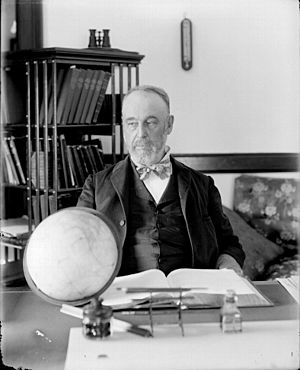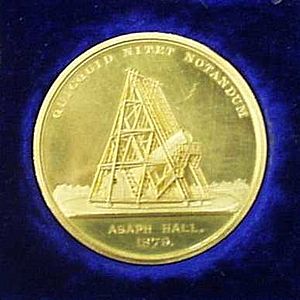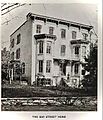Asaph Hall facts for kids
Quick facts for kids
Asaph Hall
|
|
|---|---|

Hall at the USNO in 1899
|
|
| Born | October 15, 1829 |
| Died | November 22, 1907 (aged 78) |
| Alma mater | New-York Central College, McGrawville |
| Occupation | Astronomer |
| Known for | Discovery of the two moons of Mars |
| Spouse(s) | |
| Children | 4, including Asaph Hall, Jr. and Percival Hall |
| Signature | |
Asaph Hall III (October 15, 1829 – November 22, 1907) was an American astronomer. He is famous for discovering the two moons of Mars, Deimos and Phobos, in 1877. He also studied the paths of moons around other planets. Hall figured out how fast Saturn spins and measured the mass of Mars. He also looked at double stars.
Contents
Asaph Hall's Life Story
Asaph Hall was born in Goshen, Connecticut. His father, also named Asaph Hall, was a clockmaker. When Hall was 13, his father passed away. This made things hard for his family.
So, Hall left school at 16 to become a carpenter's helper. Later, he went to New-York Central College. There, he studied math. He met Angeline Stickney, who taught geometry, and they got married in 1856.
In 1856, Hall started working at the Harvard College Observatory. He became very good at calculating the paths of objects in space, called orbits. In 1862, he joined the US Naval Observatory in Washington, D.C.. Within a year, he became a professor there.
In 1875, Hall was put in charge of the US Naval Observatory's 26-inch (66-cm) telescope. This was the biggest refracting telescope in the world at that time. He used this powerful telescope to find Phobos and Deimos in August 1877.
Hall also noticed a bright spot on Saturn. He used this spot to figure out how fast the planet rotates. In 1884, he showed that the orbit of Saturn's moon, Hyperion, was slowly moving backward. He also studied how far away stars are and looked at the stars in the Pleiades star cluster.
Finding Mars' Moons
In 1877, Mars came very close to Earth. Hall's wife, Angeline Stickney, encouraged him to look for moons around Mars. His calculations showed that any moons would be very close to the planet. Hall later wrote that he might have given up if his wife hadn't encouraged him.
Asaph Hall first saw Deimos on August 12, 1877. He then discovered Phobos on August 18, 1877. Both discoveries happened at the US Naval Observatory in Washington, D.C. He was actively searching for these moons. Hall had seen something like a moon on August 10, but bad weather stopped him from confirming it until later.
Hall wrote about his discovery of Phobos in his notebook. He tried looking on August 11 but found nothing at first. Later that night, he saw a faint object. Fog then stopped his work. Cloudy weather lasted for several days.
On August 15, the sky looked better, so he stayed at the Observatory. A thunderstorm cleared the sky, and he started searching again. But the air was very bad, and Mars was too bright and shaky. He couldn't see the object.
On August 16, he found the object again. His observations that night showed it was moving with Mars. This meant it was likely a moon. Hall told his assistant, George Anderson, that he thought he had found a moon of Mars. He asked him to keep it a secret until he was sure.
On August 17, while checking his observations, Professor Newcomb came into his room. Hall showed him his measurements. They proved the object was moving with Mars. Later that day, while waiting for the outer moon (Deimos), he discovered the inner moon (Phobos). The observations on August 17 and 18 confirmed these objects were indeed moons. Admiral Rodgers then publicly announced the discovery.
Hall retired from the Navy in 1891. He then taught about how celestial bodies move at Harvard University from 1896 to 1901.
Hall's Family
Asaph and Angeline Hall had four children. Asaph Hall, Jr. became an astronomer, just like his father. Samuel Stickney Hall worked for an insurance company. Angelo Hall became a minister and a math professor. Percival Hall became the president of Gallaudet University. Angeline Hall passed away in 1892. After retiring fully in 1901, Hall married Mary Gauthier in Goshen, Connecticut.
Asaph Hall passed away in November 1907 while visiting his son Angelo in Annapolis, Maryland.
Awards and Honors
Asaph Hall received many awards for his work. In 1878, he became a member of the American Philosophical Society. He won the Lalande Prize from the French Academy of Sciences in 1878. In 1879, he received the Gold Medal of the Royal Astronomical Society. He also received the Arago Medal in 1893. In 1896, he was made a Chevalier in the Ordre national de la Légion d'honneur (French Legion of Honor).
In 1885, he was the President of the Philosophical Society of Washington. A crater on the Moon is named Hall crater in his honor. There is also a Hall crater on Phobos, one of the Martian moons he discovered.
Images for kids
-
Hall's former home in Georgetown, after enlargement. Angeline is on the front steps.
See also
 In Spanish: Asaph Hall para niños
In Spanish: Asaph Hall para niños




